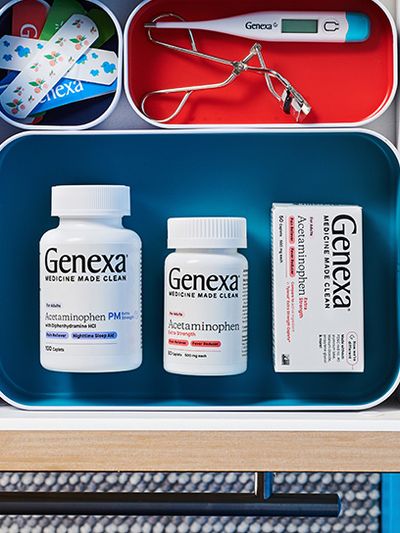Tummy Ache Relief For Kids
What To Give Your Child For A Tummy Ache
Written by Dr. Aniruddh Setya - Genexa Healthcare Provider & Partner on August 2, 2021
One of the most common complaints kids make is having a tummy ache. Stomach pain can come in many different forms, from slight but tolerable discomfort to intense burning or cramping. About 10%–15% of school-age children report episodes of recurrent pain. Another 15% experience pain but do not go to the doctor for it. Oftentimes, tummy aches in kids are not a cause for serious concern. However, there are some instances in which you should call your doctor to seek medical attention for your child.
Causes
Before looking at what you can do and give your child experiencing a tummy ache, it’s important to understand what may be causing your child’s discomfort. Given that there are several different causes of tummy aches in children, if you are unsure of the exact cause, it’s always best to seek advice from your pediatrician.
Constipation
Constipation may be the cause of your child’s tummy ache, especially if you have a young child or toddler. Constipation occurs when your child experiences pain while passing stool, passes stool less frequently than usual, and passes stool that is harder and dryer than normal.
As with tummy aches, there are several causes of constipation. However, some of the most common are inadequate amounts of fiber in your child’s diet, changes in their diet or routine, or withholding on their part due to bathroom anxiety.
Indigestion
Another possible cause of your child’s stomach ache could be ingestion, pain induced by gas. The most common cause of indigestion is diet, specifically foods that are known to upset the stomach such as spicy foods, carbonated soda, caffeine, and citrus fruit. Usually, a tummy ache caused by indigestion will create discomfort in your child’s upper abdomen.
Allergy or Intolerance
If your child complains of a tummy ache often, especially after meals, they might have some sort of food allergy or intolerance. A common food intolerance that can cause tummy aches, cramps, gas, diarrhea, or constipation is lactose intolerance.
Lactose is a sugar found in products containing milk. People who are able to digest lactose do so because their bodies produce the enzyme lactase. If your child cannot produce lactase, then milk and milk products will upset their digestive system and lead to discomfort.
Although not quite the same as lactose intolerance, another cause of your child’s stomach pain may be a milk allergy. Unlike lactose intolerance which is caused by the body’s inability to create the protein lactase, a milk allergy is caused by the body’s reaction to a specific protein in milk. The most common manifestation of a milk allergy is stomach cramping.
Overeating
Another common cause of tummy aches in children, which may be causing your child’s discomfort, is overeating. Overeating happens when a child eats too much of any food and can be specifically painful when they eat too much unhealthy food such as pizza or candy. Given that kids often eat quickly, they can have a hard time registering when they are full which means they are more likely to overeat than adults.
Stress
Stress is also a common cause of stomach pain in children. If it seems as though there are no dietary, habitual, or medical causes for your kid’s tummy ache, stress may be the cause. When kids are especially worried about something at school or with friends but don’t know how to process the feelings, the psychological discomfort can have physical manifestations. Most stomach pain caused by stress is recurrent.
Infection
Both bacterial and viral infections can develop in the stomach and be the cause of your child’s tummy ache. If your child has some kind of illness, their stomach pain will usually be followed by vomiting or diarrhea.
Appendicitis
Some of the most severe and persistent stomach pain is due to appendicitis. Usually, appendicitis occurs in older children and teenagers and is uncommon in children under the age of 5. The clearest indicator of appendicitis is intense pain on the lower, right-hand side of the abdomen such that minute movements are painful.
What Part of the Tummy is Aching?
When trying to figure out the cause of your child’s stomach pain, one of the best questions to ask can be: what part of your tummy is aching? Their answer will likely help you distinguish the cause and severity of their stomach pain.
Around the Belly Button
Usually, tummy aches around the belly button are the most common complaint kids have and are thankfully tend not to be indicators of serious illness. For the most part, stomach pain around the belly button is caused simply by stress, overeating, or eating food that they cannot digest well.
Lower, Right-Hand Side of the Abdomen
As discussed in the previous section, tummy pain on the lower, right-hand side of the abdomen is one symptom of appendicitis. Other symptoms include:
- Fever
- Vomiting
- Nausea
- Constipation
- Diarrhea
If your child has any of these symptoms and you believe they may have appendicitis, it’s a good idea to contact your doctor immediately because appendicitis can easily lead to serious health complications such as a ruptured appendix.
Left-Hand Side of the Abdomen
Stomach pain on the left-hand side of the abdomen is usually associated with constipation which is easy to treat and, although it is uncomfortable, is not cause for serious concern. Sometimes, pain in this part of the abdomen can be an indicator of a severe condition such as pancreatitis. For this reason, as with pain on the lower, right-hand side of the abdomen, it’s good to consult your doctor when your child complains of abdominal pain in this region.
Upper Abdomen
Upper abdomen pain might be a sign that your child is experiencing indigestion, as discussed in the previous section.
Other symptoms of indigestion include:
- Nausea
- Bloating
- Burping
- Heartburn
If your child describes pain in the upper, right-hand side of the tummy, this could be a sign of gallstones. Although they are more common in adults, children can develop gallstones.
What Can I Give My Kid to Relieve Their Tummy Ache?
There are several things you can give your child to relieve their tummy ache, from specific foods to medication. This section will outline all of the potential options for at-home treatment of your child’s stomach pain.
Medication
If your child’s stomach ache is very painful, you can try giving them ibuprofen or acetaminophen which will be able to temporarily relieve some of the pain or cramping after consulting with the physician. You can also try giving them medication with the active ingredient calcium carbonate if you think their tummy ache is a result of indigestion.
Oftentimes, kids’ stomach aches are caused by constipation. In order to help their body produce more regular, less painful bowel movements, you can give them a kids' laxative. As with all medication for kids, it’s important to make sure that you buy a laxative specifically made for children.
Foods and Drinks
Another way to help your child who is struggling with stomach pain is to give them specific foods and drinks that will ease the pain.
In terms of foods, it’s a good idea to give your child very bland foods when they have an upset stomach such as crackers, chicken noodle soup, and bananas. Given that nausea and vomiting sometimes accompany a tummy ache, it is best to give your child foods that will not be hard to digest or shocking in their system.
While your child has a tummy ache, it is also very important that they are drinking plenty of fluids. In particular, clear fluids such as water are by far the most beneficial because they do not have added sugar or caffeine and therefore easily work to rehydrate your child.
If your child’s stomach ache is a symptom of a viral or bacterial infection that also causes fever or vomiting, it’s especially important to give them extra fluids because both of these can lead to dehydration.
Other At-Home Remedies
Alongside medication and dietary changes, there are a few other at-home remedies you can try to ease the pain of their tummy ache.
If you have one, you can try placing a heating pad or warm compress on their stomach.
You can also try to gently massage your child’s tummy if you think the cause of their stomach ache is gas or indigestion.
Conclusion
Tummy aches, although uncomfortable and annoying for kids, are usually caused by minor ailments or illnesses. For this reason, it is often possible to treat stomach pain at home with over-the-counter medication such as pain relievers and laxatives.
It’s important to remember that where your child’s stomach is aching is often an indicator of the cause of their pain. If you are having trouble discerning the exact cause of your child’s pain or have any questions about treatment, it’s always best to consult a doctor.





